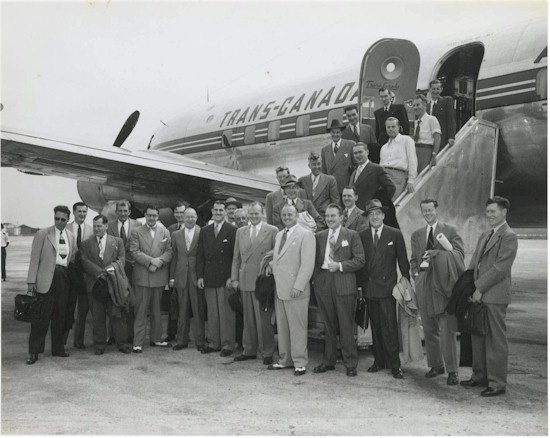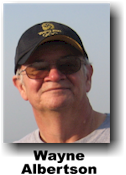Irving F. Thomas
submitted by Mary Lou Mailloux
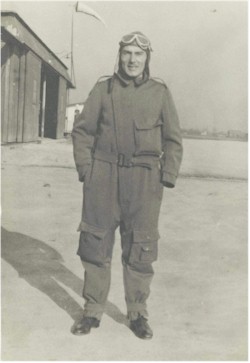 As many of us have been doing during these unusual COVID times, I have been sorting papers and came across a letter from one of Trans-Canada Air Lines first employees, Irving F. Thomas, a family friend and fellow cottager at Sauble Beach, Ontario. The letter was post marked 1991 and I, at the time, was an Air Canada passenger agent at YQGTR (Windsor, Ontario) so his recollections of the early days of the airline were of particular interest to yours truly and would love to share.
As many of us have been doing during these unusual COVID times, I have been sorting papers and came across a letter from one of Trans-Canada Air Lines first employees, Irving F. Thomas, a family friend and fellow cottager at Sauble Beach, Ontario. The letter was post marked 1991 and I, at the time, was an Air Canada passenger agent at YQGTR (Windsor, Ontario) so his recollections of the early days of the airline were of particular interest to yours truly and would love to share.
First, some background information about Mr. Thomas which was willingly supplied by his niece, Anne Venton, who I wish to thank for providing same as my memory is a bit rusty about all those details.
Irving F. Thomas was the fourth employee hired to organize Trans-Canada Air Lines. He was a recent graduate from the University of St. Louis, Missouri, the Aeronautical Division, receiving his Bachelor of Science degree in Aviation Administration and also a U.S. Transport Pilots license, including instrument rating in 1936.
He was hired by C.D Howe when Howe was Federal Minister of Munitions and Supply in the King government and later Minister of Transport. Mr. Thomas played a key role in planning the airline which was initially to serve Winnipeg to Vancouver and subsequently across Canada, U.S.A, the Caribbean and Europe.
In 1942, Mr. Thomas became T.C.A.’s Operations Manager at LaGuardia airport in New York and during this time he describes some highlights of his career including meeting movie stars, politicians and having the Pope present him with a medal at the Vatican. It is this meeting in Rome which the following describes in his letter.
“This noteworthy meeting occurred in 1949 when a Papal messenger from the Vatican interrupted our Saturday morning airline Research Plenary session in the Grand Hotel and delivered a personal invitation from the hand of Pope Pius XII for our nine international airline executives to visit him at his Vatican residence in the palace that afternoon. Being the invitation was addressed to me, as chairman, I graciously accepted.
This was a total surprise on our part. As it turned out, upon our arrival at the Papal reception hall, the Pope’s personal secretary advised me that His Holiness wished to learn more about International Aviation and I advised him that I represented Trans-Canada Air Lines, ICAO (International Civil Aviation Organization) and also the Federal Air Services.
The Pope wished to interview each airline representative separately which were T.C.A., American Airlines, Trans-Continental and Western Air, Air France, British Overseas Airways, Royal Dutch Airlines, British European Airways, Sabena (Belgium) and Sweden- Norwegian Airlines.
Upon meeting with the Pope, with his secretary attending, by reason of his official invitation, he outlined that up until 1949, the Papacy had not used international air transport services for Vatican Papal visits to foreign countries and his Holiness began questioning each air carrier on it’s performance and safety standards.
It was my distinction to enjoy the longest interview separately with the Pope, explaining the purpose of our Research Session to seek ways and methods of standardizing all airline operations methods for world travel safety. He was most curious as to how this new ICAO organization would develop to control safety standards and maintain same. He also realized that T.C.A. was in the foreground of this much needed international air travel development, in that we were working closely with the ICAO offices and the member-state ambassadors in Montreal and with IATA headquartered in Montreal for every international airline in the world.
The Pope expressed gratitude for this “learning session” and gave us each a blessing and holy medallion. I took this occasion, with his blessing, to present the Pope with a copy of our provisional airline operating regulations.
It is most gratifying to realize today that our efforts on standardizing airline operations have provided safe and comfortable air travel for his Holiness to visit every continent and country on our planet.
With kindest personal regards,
Irving F. Thomas “
(Footnote: Mr. Thomas retired in 1965 after almost 30 years in which he saw T.C.A. develop into world class Air Canada. It is indeed an honour and a privilege to have known this remarkable pioneer of the airline industry.)
Photographs:
Mr. Thomas at Parks Air College in December 18, 1935 (above).
A group photo, time and place unknown. Mr. Thomas is 4th from right next to man with hat (below).
Mary Lou Mailloux,
Retired Air Canada Sales
Embarrassed by Murphy's Law
submitted by Ralph Quick
"If anything can go wrong it will ". This is Murphy's Law which originated in aviation. Pilots fly their whole career, making sure they look ahead for what can go wrong and making sure it does not happen. Results of having an incident going unforeseen can lead to an accident, aircraft damage, or at the very least embarrassment. My encounter with Murphy's Law was caused by distraction and ended with embarrassment.
My distraction was provided by an Omega Navigation System (forerunner of modern GPS) that had been installed in my CP Air Boeing 737. It only appeared on this one flight, never to be seen again on any other flights. We left Vancouver for Edmonton on an 'all stops' to Montreal. At cruising altitude, we tried to set up the system by putting in waypoints to see how it worked. As we had had no instruction, it did not, no matter what we did.
On arrival at YEG there were no gates available, so we parked on the far side of the tarmac and were serviced by a PTV (Passenger Transfer Vehicle). Standard procedure was for the front door to be opened as the PTV arrived, deplane the passengers, then extend the "airstairs" with the door open after PTV departed. Airstairs would be retracted when the PTV arrived back to load the passengers for departure, and we would then receive our late load.
While we sat there, the F/O and I became totally absorbed in the Nav system with our heads down not looking outside, trying to figure it out. We came back to reality when the late load arrived on the radio. I looked up and door and airstair lights were out, a mechanic walked up and connected to us. I said, "ready to start" and he cleared us to start engines.
Our taxi time to end of runway for takeoff was about 1 1/2 minutes. We were about 20 seconds to takeoff and just going to change to tower frequency when I hear a plaintive voice on the radio,
“Empress — PTV 1, don't you want your passengers?" Murphy had struck.
Much embarrassed, I did a quick 1 1/2-minute taxi back to the ramp, loaded the passengers, and away we went.
My luck was that it was not the era of social media. I only had to endure seeing a cartoon on the bulletin board at Edmonton (YEG) for about a month, at which time it was given to me. It was great, showing a PTV on the highway to Winnipeg chasing an aircraft disappearing to the east with the caption "don't you want your passengers? ". Unfortunately, I can't share it with you as it went missing after our last move.
What caught me was when I looked up, the door and airstair lights were out indicating we had been loaded. Only problem was I had forgotten that the airstairs were unserviceable and because of that the door was closed. Too many heads in the cockpit and no one else noticed that no passengers had been loaded. But nonetheless the buck stops in the left seat and I wore the horns.
Just to add to this story the PTV unloaded over 50 passengers, including the entire New York Rangers hockey team. If we had gone another minute, we would have been airborne and had to return then take a delay topping up the fuel delaying the team for their game that night.
I have been retired 27 years so it's easy to share this story. Any other pilots out there willing to share their encounter with Murphy's Law?
Ralph Quick
Anatomy of a Negotiation
submitted by Norm Foster
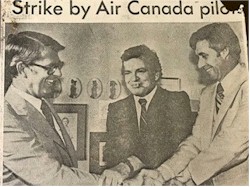 Pictured at left, Claude Taylor, John Munro and Norm Foster. The 3 principals shaking hands and later sharing a cognac spread across the front page of every major Canadian newspaper.
Pictured at left, Claude Taylor, John Munro and Norm Foster. The 3 principals shaking hands and later sharing a cognac spread across the front page of every major Canadian newspaper.
We stood side by side in an elevator heading for a suite on the 14th floor. I stared straight ahead trying to look serious, cool and composed. I could feel him look me up and down and then he joined me in staring at the door. Although we had never met before, we had been very aware of each other for several years. As we passed the 10th floor he turned and spoke to me for the first time. “I don’t see the horns my people say you have?”
His name was Taylor……Claude Taylor, and he was the head of Air Canada. I represented Air Canada’s pilots as Chairman of the Master Executive Council (MEC) as well as the chief negotiator, and we were at war!
In their roughly 45-year history, there had never been an industrial strike by the Air Canada pilots. Professionalism and Marquis of Queensbury rules had always prevailed, and contracts were ultimately negotiated to a mutually satisfactory conclusion. In the late 70’s, Canada was operating under Government imposed Wage and Price controls and these constraints made a wage settlement a non-issue. However, Air Canada had recently taken two actions negatively affecting its pilots and which resulted in us placing these items into the current contract negotiations.
The one-on-one meeting on the 14th floor had resolved nothing. As we shook hands and parted I was more sure than ever that a peaceful settlement, if possible, would only come at the final hour, or failing that, we would face our first strike. Becoming a test of strength and resolve, and as both sides dug in, our team began preparations for the showdown.
First, and most important, our negotiating team went across the country on a ‘Roadshow’, where we explained to the pilots the untenable position Air Canada’s actions had put us in. The success of this endeavor was proven by the results…. an unprecedented strike vote of 97%.
Because a strike at Air Canada would virtually shut down travel across the country, the Government had begun playing close attention. When we announced the strength of our mandate, we had their full attention and they immediately appointed the Minister of Labor, Mr. John Munro, to mediate. The strike deadline was Thursday and John Munro directed both parties to meet on that day at 10 a.m. to resume negotiations, and with his assistance, to reach an agreement. Our next move proved critical.
For the pilots of CALPA to go on strike, there are several steps to be taken. First, an honest and exhaustive negotiation must have come to an impasse and the Negotiating Team therefore recommends the action. The entire membership must then vote to indicate support for the action. CALPA’s Board of Directors then must vote to approve the action. Lastly, the 8-member Master Executive council must vote to give its final approval.
Meeting on that fateful Thursday, all the criteria for strike approval had been met……. but for the final vote of the Master Executive Council. For this purpose, I had arranged for a conference phone call to take place with the 8 members who were spread across the country from Montreal to Vancouver, for exactly 7 p.m. It was agreed that on that call there was to be no discussion. As the issues were clear and came down to yes or no, I would convene the call, and declare we had an agreement…. Yes or No. Following my one word “Yes” or “No” the vote would then be taken…. .and everyone would hang up.
The understanding and impact of this final item was of paramount importance. At our Thursday 10 a.m. commencement, I advised the Minister of Labor of the critical nature of the 7 p.m. call. It was made clear that without agreement, and with that phone call, it was taken out of my hands.
Logistically, it was me and CALPA’s Director of Industrial Relations, Ron Young, in one room. At the far end of a long hall was Claude Taylor and his team. The Honorable John Munro carried messages between rooms and cajoled and coerced both parties the entire day. It is difficult to remember how we could spend 9 hours restating and rehashing positions that had not changed in weeks. What I do remember was the startling jangle of the phone at exactly 7 p.m.
As the time counted down, John Munro came to realize and accept that CALPA's position was nonnegotiable. If there was to be an agreement, movement had to come from Mr. Taylor. He alone could undo his actions that got us to this point. Vividly, I recall Munro rushing into our room at 6:55 p.m. and pleading for more time, as he felt that Mr. Taylor was feeling the pressure to move. Apologetically, I restated our 10 a.m. discussion. In 5 more minutes, it was out of my hands. As he rushed back down the hall, he could hear the phone ringing in his ears.
What had been a great idea when planned, suddenly became a double-edged sword. I could sense victory at hand, but had no time left to grasp it. After 6 rings I reluctantly picked up the phone. To angry calls for “Yes or No” I tried to stall for time. Facing a mutiny, my final gambit was to require a verbal roll call prior to the vote to confirm the proper make-up of the conference call. Finally, out of ideas, I had “No” halfway out of my mouth when Munro, breathless from his lengthy dash down the hall, burst through the door and gasped “Yes!!!!!”
Epilogue:
Ironically, members of one of Air Canada’s unions that had recently completed a bitter negotiation, reacted immediately by commencing a wildcat strike, virtually shutting the airline down for 3 days.
Upcoming events and/ or past event reports
|
|
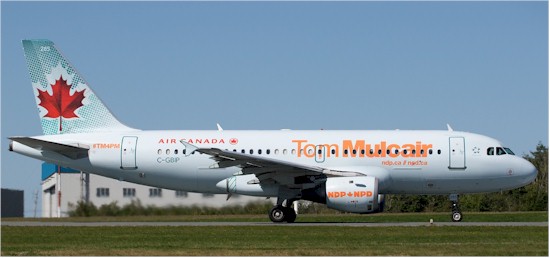 |
| Photo courtesy of Michael Durning at Airliners.net |

